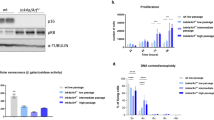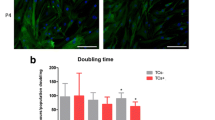Abstract
Purpose
Results of in vitro cell models are commonly used to promote new therapies (e.g., platelet-rich plasma), and clinicians have to be aware of the specific limitations of such models. To gain a sufficient and effective cell load, many current in vitro models use cells multiplied through various passages. This is especially important in tendon-like cell (TLC) models, since native tendon tissue is not available unlimited and contains limited amount of tenocytes. The purpose was to determine the occurrence of phenotypic changes following extended monolayer culture of TLCs, according to cell-passage number.
Methods
Tendon samples were obtained from 15 healthy patients undergoing biceps tenodesis. Tendons were digested and cultured (monolayer) for six passages. Tendon-specific markers (collagens I and III, decorin, tenascin-C, and tenomodulin) and their histology were analyzed using gene expression and protein content assays. Native cells, the cells cultured and cells passaged one to six times were analyzed at each passage.
Results
Gene expression of types I and III collagen of cultured TLCs significantly decreased after two passages. Gene expression of decorin, tenascin-C, and tenomodulin exhibited a trend of decreased gene expression with increased passage. Protein levels of types I and III collagen and decorin decreased after four passages.
Conclusions
The significant findings let conclude that tenocyte-like cells obtained from human LHB can be maintained in monolayer culture at low passages, before the signs of phenotypic drift are present. But researchers must be aware of rapid phenotypic drift at higher passage numbers. Therefore, only cells within the first 3 passages should be used as a precaution for in vitro monolayer cell models, and one has to be aware of the phenotypic changes if TLCs passaged multiple times are used. The clinical relevance of this data is that understanding of in vitro TLC models, and their limitations may finally help the clinician to judge the potential of experimental data of new biologic treatment options.



Similar content being viewed by others
References
Almarza AJ, Augustine SM, Woo SL (2008) Changes in gene expression of matrix constituents with respect to passage of ligament and tendon fibroblasts. Ann Biomed Eng 36(12):1927–1933
Bernard-Beaubois K, Hecquet C, Houcine O, Hayem G, Adolphe M (1997) Culture and characterization of juvenile rabbit tenocytes. Cell Biol Toxicol 13(2):103–113
de Wreede R, Ralphs JR (2009) Deposition of collagenous matrices by tendon fibroblasts in vitro: a comparison of fibroblast behavior in pellet cultures and a novel three-dimensional Long-term Scaffoldless culture system. Tissue Eng Part A 15(9):2707–2715
Denaro V, Ruzzini L, Longo UG, Franceschi F, De Paola B, Cittadini A, Maffulli N, Sgambato A (2010) Effect of dihydrotestosterone on cultured human tenocytes from intact supraspinatus tendon. Knee Surg Sports Traumatol Arthrosc 18(7):971–976
Doroski DM, Brink KS, Temenoff JS (2007) Techniques for biological characterization of tissue-engineered tendon and ligament. Biomaterials 28(2):187–202
Fu SC, Cheuk YC, Chan KM, Hung LK, Wong MW (2008) Is cultured tendon fibroblast a good model to study tendon healing? J Orthop Res 26(3):374–383
Joseph M, Maresh CM, McCarthy MB, Kraemer WJ, Ledgard F, Arciero CL, Anderson JM, Nindl BC, Mazzocca AD (2009) Histological and molecular analysis of the biceps tendon long head post-tenotomy. J Orthop Res 27(10):1379–1385
Kovacevic D, Rodeo SA (2008) Biological augmentation of rotator cuff tendon repair. Clin Orthop Relat Res 466(3):622–633
Kuc IM, Scott PG (1997) Increased diameters of collagen fibrils precipitated in vitro in the presence of decorin from various connective tissues. Connect Tissue Res 36(4):287–296
Maffulli N, Yao L, Bestwick C, Bestwick L, Aspden R (2008) Phenotypic drift in human tenocyte culture. J Bone Joint Surg Br 90-B (SUPP_III):494-a
Mazzocca AD, McCarthy MB, Arciero C, Jhaveri A, Obopilwe E, Rincon L, Wyman J, Gronowicz GA, Arciero RA (2007) Tendon and bone responses to a collagen-coated suture material. J Shoulder Elbow Surg 16(5 Suppl):S222–S230
Moffat KL, Kwei AS, Spalazzi JP, Doty SB, Levine WN, Lu HH (2009) Novel nanofiber-based scaffold for rotator cuff repair and augmentation. Tissue Eng Part A 15(1):115–126
Pauly S, Klatte F, Strobel C, Schmidmaier G, Greiner S, Scheibel M, Wildemann B (2010) Characterization of tendon cell cultures of the human rotator cuff. Eur Cell Mater 20:84–97
Pringle GA, Dodd CM (1990) Immunoelectron microscopic localization of the core protein of decorin near the d and e bands of tendon collagen fibrils by use of monoclonal antibodies. J Histochem Cytochem 38(10):1405–1411
Rodeo SA (2007) Biologic augmentation of rotator cuff tendon repair. J Shoulder Elbow Surg 16(5, Supplement 1):S191–S197
Schulze-Tanzil G, Mobasheri A, Clegg PD, Sendzik J, John T, Shakibaei M (2004) Cultivation of human tenocytes in high-density culture. Histochem Cell Biol 122(3):219–228
Schweitzer R, Chyung JH, Murtaugh LC, Brent AE, Rosen V, Olson EN, Lassar A, Tabin CJ (2001) Analysis of the tendon cell fate using Scleraxis, a specific marker for tendons and ligaments. Development 128(19):3855–3866
Stoll C, John T, Endres M, Rosen C, Kaps C, Kohl B, Sittinger M, Ertel W, Schulze-Tanzil G (2010) Extracellular matrix expression of human tenocytes in three-dimensional air-liquid and PLGA cultures compared with tendon tissue: implications for tendon tissue engineering. J Orthop Res 28(9):1170–1177
Taylor SE, Vaughan-Thomas A, Clements DN, Pinchbeck G, Macrory LC, Smith RK, Clegg PD (2009) Gene expression markers of tendon fibroblasts in normal and diseased tissue compared to monolayer and three dimensional culture systems. BMC Musculoskelet Disord 10:27
Teicher BA, Maehara Y, Kakeji Y, Ara G, Keyes SR, Wong J, Herbst R (1997) Reversal of in vivo drug resistance by the transforming growth factor-beta inhibitor decorin. Int J Cancer 71(1):49–58
Tenni R, Viola M, Welser F, Sini P, Giudici C, Rossi A, Tira ME (2002) Interaction of decorin with CNBr peptides from collagens I and II. Evidence for multiple binding sites and essential lysyl residues in collagen. Eur J Biochem 269(5):1428–1437
Theisen C, Fuchs-Winkelmann S, Knappstein K, Efe T, Schmitt J, Paletta JR, Schofer MD (2010) Influence of nanofibers on growth and gene expression of human tendon derived fibroblast. Biomed Eng Online 9:9
Wong MW, Tang YY, Lee SK, Fu BS, Chan BP, Chan CK (2003) Effect of dexamethasone on cultured human tenocytes and its reversibility by platelet-derived growth factor. J Bone Joint Surg Am 85-A(10):1914–1920
Yao L, Bestwick CS, Bestwick LA, Maffulli N, Aspden RM (2006) Phenotypic drift in human tenocyte culture. Tissue Eng 12(7):1843–1849
Yoon JH, Brooks RL Jr, Zhao JZ, Isaacs D, Halper J (2004) The effects of enrofloxacin on decorin and glycosaminoglycans in avian tendon cell cultures. Arch Toxicol 78(10):599–608
Zhang L, Tran N, Chen HQ, Kahn CJ, Marchal S, Groubatch F, Wang X (2008) Time-related changes in expression of collagen types I and III and of tenascin-C in rat bone mesenchymal stem cells under co-culture with ligament fibroblasts or uniaxial stretching. Cell Tissue Res 332(1):101–109
Acknowledgments
The University of Connecticut Health Center/New England Musculoskeletal Institute has received direct funding, and material support for this study was provided by Arthrex Inc. (Naples, Fl). The company had no influence on study design, data collection or interpretation of the results. Augustus D Mazzocca receives research support and is a consultant for Arthrex, Inc.; all other authors, their immediate family, and any research foundation with which they are affiliated have not received any financial payments or other benefits from any commercial entity related to the subject of this article.
Author information
Authors and Affiliations
Corresponding author
Rights and permissions
About this article
Cite this article
Mazzocca, A.D., Chowaniec, D., McCarthy, M.B. et al. In vitro changes in human tenocyte cultures obtained from proximal biceps tendon: multiple passages result in changes in routine cell markers. Knee Surg Sports Traumatol Arthrosc 20, 1666–1672 (2012). https://doi.org/10.1007/s00167-011-1711-x
Received:
Accepted:
Published:
Issue Date:
DOI: https://doi.org/10.1007/s00167-011-1711-x




